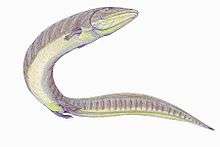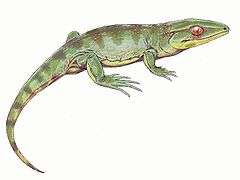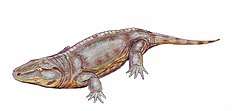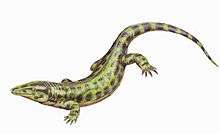Proterogyrinus
Proterogyrinus was an extinct genus of early tetrapods from the order Embolomeri. Fossils have been found in Scotland, UK, and West Virginia, United States and date back to the Serpukhovian (mid-Carboniferous period) from about 331-323 million years ago.[1] The genus was originally named by renowned vertebrate paleontologist Alfred Sherwood Romer in 1970.[2] A comprehensive redescription was later published by Canadian paleontologist Robert Holmes in 1984.[3] The generic name "Proterogyrinus" is Greek for "earlier wanderer" or "earlier tadpole". This name was chosen by Romer in keeping with a trend of naming long-bodied early tetrapods (such as Eogyrinus and Crassigyrinus) with the suffix "-gyrinus".[2]
| Proterogyrinus | |
|---|---|
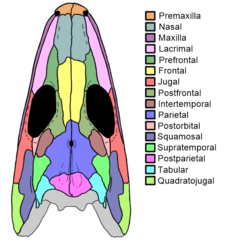 | |
| Skull diagram | |
| Scientific classification | |
| Kingdom: | Animalia |
| Phylum: | Chordata |
| Order: | †Embolomeri |
| Family: | †Proterogyrinidae |
| Genus: | †Proterogyrinus Romer, 1970 |
| Type species | |
| †Proterogyrinus scheelei Romer, 1970 | |
| Other species | |
| |
| Synonyms | |
| |

Romer hesitated from designating Proterogyrinus as a true embolomere, because its intercentra (the forward portion of each vertebra) were smaller than its pleurocentra (the rear portion). He used the group Anthracosauria to encompass embolomeres and their close relatives such as Proterogyrinus.[2] However, other sources prefer a wider definition of Embolomeri similar in usage to Romer's Anthracosauria, thus counting Proterogyrinus as an embolomere.[3]
Description
In most respects Proterogyrinus resembled other embolomeres such as Archeria, with a moderately elongated skull that was taller than that of other early tetrapods such as colosteids and temnospondyls. They were similar in size and shape to other prehistoric amphibians such as Crassigyrinus and Eryops, about two and a half meters (7–8 feet) long. This would have put them in line with the largest modern lizards. Members of the genus had strong limbs with several fully-ossified ankle and wrist bones. This would have given Proterogyrinus the ability to walk and hunt on land. However, the presence of lateral line grooves and otic notches which likely held spiracles show that they were probably more well-adapted for the water. The tail was long and tall, and was likely a powerful method of locomotion. The eyes were positioned high on the skull, supporting the idea that Proterogyrinus had an active lifestyle near the surface of the water.[3]
References
- Haines, Tim; Paul Chambers (2006). The Complete Guide to Prehistoric Life. Canada: Firefly Books. p. 38.
- Romer, A.S. (30 April 1970). "A new anthracosaurian labyrinthodont, Proterogyrinus scheelei, from the Lower Carboniferous". Kirtlandia. 10: 1–16.
- Holmes, R. (2 November 1984). "The Carboniferous Amphibian Proterogyrinus scheelei Romer, and the Early Evolution of Tetrapods". Philosophical Transactions of the Royal Society of London. Series B, Biological Sciences. 306 (1130): 431–524. doi:10.1098/rstb.1984.0103.
